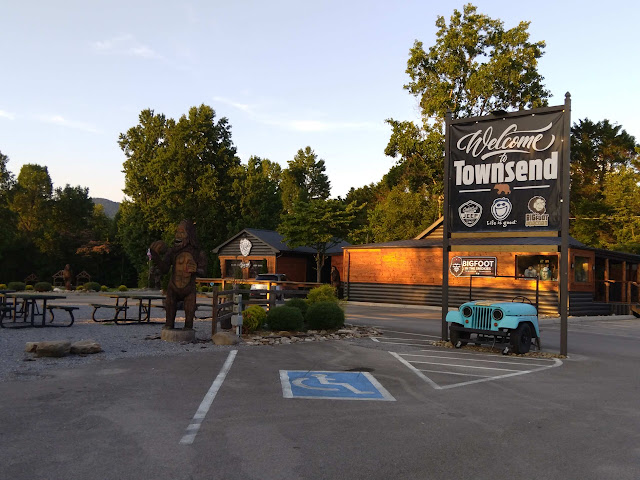Between Gatlinburg and Pigeon Forge it's hard to know what you are feeling. Traffic streaming in all directions. Your choice of at least two hundred area attractions. The postCOVID mix of acceptance and ambition on economy. We wonder at ourselves in each other.
Somebody else honked where it says NO HONKING IN TUNNEL; Should I?
America at Fourth of July has always been the perfect blend of union and independence America. Even in years when its scary unknown-exactly about the future we know who we are.
A couple cracks! and POPS of fireworks getting closer to the holiday.
A Gateway to the Smokies, Townsend toasts this elevation with a loop of finely paved road with nice slopes and curves (perfect practice for the Blue Ridge Parkway) and camping at Cades Cove.
Sunset. In the distance an urban center's heat rises and flattens the bottom of a cloud bank. The straightline clouds are eagle-gray in the box of pastels.
"Got somethin' down yonder," a voice assures another voice. Optimism, sight unseen, to any "problem".
Night falls. Traffic sorts itself, coming, going. Settling in for the night.
The way to the Great Smoky Mountains Institute at Tremont is as much public estate as it is an edge of backcountry. For me it's just as weighty American as the Lincoln Memorial or the White House. It's both barometer on how we're doing taking care of at least some nature, and, it's proof that the dark green of "park"/conservancy is as steadfast as the red, white, and blue of Old Glory.
In the Smokies people work together as much as they work individually to protect and defend our natural resources. A ranger's station in the area has some copies of Smokies Guide, The Official Newspaper of the Smokies, Summer 2024, and I'm able to catch up on stats like merit badges. In a feature called GSMNP we can see the work pays off. Here there are 31 species of salamanders; 69 species of mammals; 10,400 species of insects; and more than 1000 species new to science found in the park!
America has, in the Great Smokies National Park system...more than 250 species of birds, 2900 miles of streams, 848 miles of trails, 135 species of trees, 3500 species of fungi, 500,000 acres of land, and +90 historic structures.
There are educational programs. There is coordinated and successful trail rehabilitation, preservation, conservation and management. The Parks system works year after year keeping facilities up to par, making accessibility improvements, and working with all kinds of professionals to see how best to hold the fort down so that GSMNP remains a stalwart and a beacon.







No comments:
Post a Comment